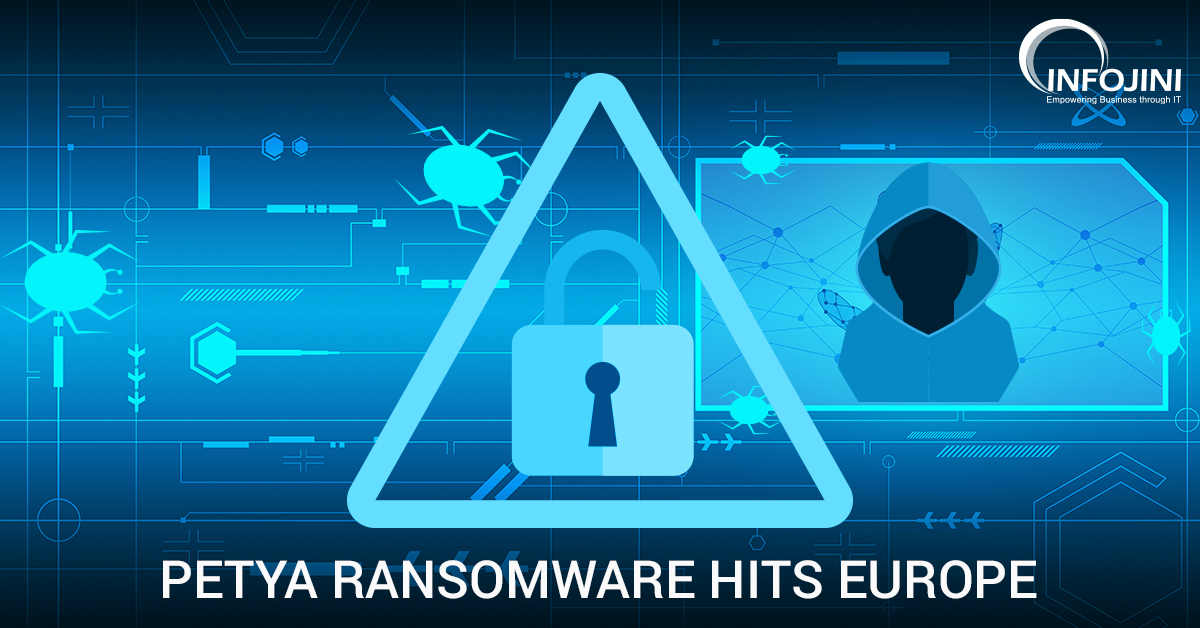Petya Ransomware Attacks companies across Europe and US
A destructive cyberattack – Petya Ransomware has strike companies across the United States and Europe. Ukraine government, banks and electricity grid hit hardest, but companies in France, Denmark and Pittsburgh, Pennsylvania also attacked.
The “Petya” ransomware has triggered severe disruption at large firms including the advertising giant WPP, French construction material company Saint-Gobain and Russian steel and oil firms Evraz and Rosneft, the world’s largest shipping firm, Maersk.
Septic PC and computers show a message demanding a Bitcoin ransom worth $300. Those who pay are asked to send confirmation of payment to an email address. However, that email ID has been shut down by the email provider.
This attack was initially reported in Ukraine, where the government banks, state power utility and Kiev’s airport and metro system were all affected.
Ukrainian PM Volodymyr Groysman called the attack “unprecedented” after several companies and the country’s main airport were hit by hackers. Many companies in the UK, Germany, and Netherlands reported that they were also targeted.

How does the “Petya” ransomware work?
The ransomware takes over computers and demands $300, paid in Bitcoin. The malicious software spreads rapidly across an organization once a computer is infected using the EternalBlue vulnerability in Microsoft Windows (Microsoft has released a patch, but not everyone will have installed it) or through two Windows administrative tools. The malware tries one option and if it doesn’t work, it tries the next one. “It has a better mechanism for spreading itself than WannaCry”, said Ryan Kalember from cybersecurity company Proofpoint.
What to do if you are affected by the ransomware?
- Usually what happens is – the ransomware infects computers and then waits for approximately an hour before rebooting the computer. So, when the system is rebooting, you can switch off the computer to prevent the files from being encrypted and try and rescue the files from the system.
- If the machine gets reboots with the ransom note, don’t pay the ransom because the “customer service” email address has been shut down so there’s no way to get the decryption key to unlock your files anyway.
- Disconnect your PC from the internet, reformat the hard drive and reinstall your files from a backup.
- Back up your files regularly and keep your anti-virus software up to date.
Source: The Guardian
ABC News
Related Posts
Leave a Reply Cancel reply
Subscribe For Updates
Categories
- Accountant
- AI
- Automation
- Awards and Recognitions
- Blue Collar Staffing
- Burnouts
- Campus Recruiting
- Cloud
- Co-Ops agreements
- Company Culture
- Compliance
- Contingent Workforce
- contingent workforce
- COVID-19
- Cyber Security Staffing
- direct sourcing
- Distributed Workforce
- Diversity
- Diversity & Inclusion
- Economy
- Events & Conferences
- fleet industry
- Gig Economy
- Global Talent Research and Staffing
- Government
- Healthcare
- Healthcare Staffing
- Hiring Process
- Hiring Trends
- Home Helathcare
- HR
- HR Practices
- HR Tech
- IT
- Labor Shortages
- Life Science
- Local Governments
- News
- Nursing
- Payroll Staffing
- Public Sectors
- Recruiting
- Remote Work
- Skill Gap
- SMB Hiring
- Staffing
- Staffing Augmentation
- Staffing Challenges
- Talent ROI
- Tech Staffing
- Technology
- Tips & tricks
- Total Talent Management
- UI/UX Design
- Uncategorized
- Veteran Staffing
- Veterans Hiring
- Veterans Hiring
- Workforce Management
Recent Posts
Archive
- April 2024
- March 2024
- February 2024
- January 2024
- December 2023
- November 2023
- October 2023
- September 2023
- August 2023
- July 2023
- June 2023
- May 2023
- April 2023
- March 2023
- February 2023
- December 2022
- November 2022
- October 2022
- September 2022
- August 2022
- July 2022
- June 2022
- November 2021
- October 2021
- September 2021
- August 2021
- July 2021
- June 2021
- May 2021
- April 2021
- March 2021
- February 2021
- January 2021
- December 2020
- November 2020
- October 2020
- September 2020
- August 2020
- July 2020
- June 2020
- May 2020
- April 2020
- March 2020
- February 2020
- January 2020
- December 2019
- November 2019
- October 2019
- September 2019
- August 2019
- July 2019
- June 2019
- May 2019
- January 2019
- December 2018
- November 2018
- October 2018
- September 2018
- August 2018
- July 2018
- June 2018
- May 2018
- April 2018
- March 2018
- February 2018
- January 2018
- December 2017
- November 2017
- October 2017
- September 2017
- August 2017
- July 2017
- June 2017
- May 2017
- November 2016
- October 2016